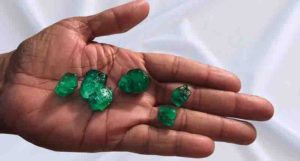
What is Emerald?
Emerald is a gemstone and a range of green-colored mineral beryl (Be3Al2(SiO3)6) by trace quantities of chromium and sometimes vanadium. On Mohs scale, Beryl has a durability of 7.5–8. Included are the most emeralds, so their toughness (crash resistance) is usually considered poor. The emerald is cyclosilicates. Emerald is an emerald.
The term “emerald” is obtained from Vulgar Latin (via Old French: esmeraude and Middle English: emeraude): esmaralda / esmaraldus, a version of Latin smaragdus which emerged in Ancient Greek (smaragdos).
Emeralds, like all colored gemstones, are graded using four fundamental parameters–the four Cs of knowledge: colour, clarity, cut and weight of the carat. Normally, color is the most significant factor in the grading of colored gemstones. However, transparency is regarded to be a near second in the grading of emeralds. A good emerald must have as outlined below not only a sheer green hue, but also a large degree of transparency to be regarded a top gem.
Emerald’s Color
Color is split into three parts in gemology: hue, saturation, and tone. Emeralds are present in hues varying from yellow-green to blue-green, the main hue being green. The standard secondary hues observed in emeralds are yellow and blue. Emeralds are regarded only gems that are medium to light in color; light-tone gems are regarded as green beryl instead.
On a scale where 0 percent color is colorless and 100 percent opaque white, the best emeralds are about 75 percent color. Moreover, it will saturate a good emerald and have a bright (vivid) colour. Gray is the ordinary modifier of saturation or mask discovered in emeralds; a dull-green hue is a grayish-green hue.
Emerald in the United States
North Carolina and South Carolina
In the United States very few emeralds were mined. Since the late 1800s, North Carolina was a sporadic producer of small amounts of emeralds from a few mines.
Tiffany and Company and a number of landowners operated the Crabtree Emerald mine from 1894 to the 1990s. Many fine, transparent emeralds have been developed and tonnes, slabbed and cabochon cutting, of smart pegmatitis have been marketed as a “emerald matrix.”
In a white matrix of glass and feldspath the cabochons had jade and tourmaline prisms. This page displays a sample of the Crabtree Pegmatite.
North American
A tiny mine close Hiddenite, North America Emerald Mines works in North Carolina. Between 1995 and 2010, the Houston Museum of Natural Science manufactured over 20,000 carats of emeraldean, including six inch length 1.869-carat crystal valuable at $3.5 million.
On the same premises a crushed stone quarry is run by employees watching for hydrothermal vein signs and bags that contain emeralds at times. It is one of the world’s only precious mines that sells rural rock.










